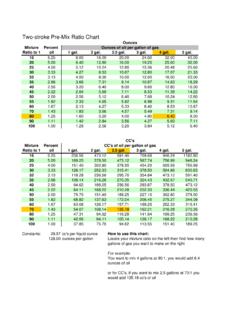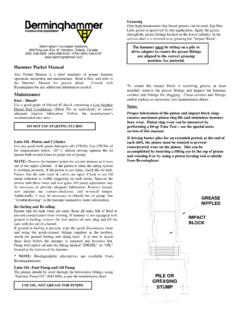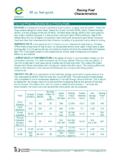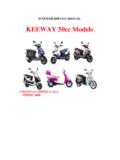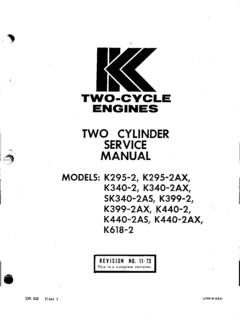Transcription of Understanding Modern 2-Cycle Lubricants - A 2 stroke ...
1 Understanding Modern 2-Cycle Lubricants by Mark Zaic Legend Performance, Inc. Current production snowmobiles available from today's manufactures represent an advancement in performance and technology. This level of sophistication has resulted from years of continual improvement in manufacturing processes as well as innovative engineering design. The Lubricants that protect these high-tech machines have also undergone continual change over the years. These advancements in chemistry have provided better protection and reduced emissions, but as we will learn, not all these changes have produced positive long-term benefits.
2 This article will describe the history of two-cycle oils, the trend of technology through the years to today's current petroleum and synthetic Lubricants and explain how they are chemically engineered. We will also compare the advantages and disadvantages of both types of oils so you can decide for yourself what oil is right for your snowmobile. First of all, two-cycle oils (abbreviated 2T) differ from four-cycle Lubricants (abbreviated 4T) in the fact that 2T Lubricants "must combust or burn" and are chemically altered to do so. Four- stroke , 4T oils are designed "not to burn" or combust and have different chemistry profiles that inhibit consumption by the engine.
3 It is therefore for those unique and completely opposite operating requirements that a classification needed to be assigned to differentiate the oils based on the engine design cycle (2 vs. 4 stroke ). The NMMA (National Marine Manufactures Association) was the first to set the standards for two-cycle oils (2T). beginning in 1960. Listed below is a timeline for the various ratings: NMMA Ratings TC-W (air cooled) -- 1960-1988. TC-WII (water cooled) -- 1988-1995. TC-W3 (water cooled/marine) -- 1992-1996. Recertified TC-W3 -- 1996-current As you can see, we are currently under a "recertified" TC-W3 classification for two-cycle Lubricants that was driven by some of the OEM's to improve detergency, lubricity and reduce ring sticking.
4 All 2T oils today must meet the TC-W3 rating to be OEM approved and maintain your warranty requirements set forth by the manufacture. Back in the early 1990's, Japan as a major manufacture of two-strokes, decided it needed it's own standard to rate and develop 2T oils for quality assurance purposes. The API (American Petroleum Institute-USA) was the only automotive standard at the time. This standard did not meet the higher quality testing criteria for oils the Japanese desired as their testing methods were much more severe and wider in scope than the API's TA, TB, TC rating format. On July 1st, 1994, the marketing of JASO (Japanese Automobile Standards Organization) oil began worldwide.
5 Being of a higher quality requirement than the USA API standard, this provided many developing countries the criteria to formulate and test their Lubricants with. Figure 1. illustrates the JASO Standard of classification for 2T oils. JASO classification for 2T. oils are FA, FB, FC, FC is the highest JASO rating. Most currently available 2T oils meet the JASO FB rating, only premium 2T oils obtain an FC classification. JASO TWO- stroke QUALITY CLASSIFICATION SYSTEM. Parameter Test Engine Fuel:Oil JASO Classification and Test Ratio FA FB FC. Detergency Honda super 100:1 80 85 95. (1 hr) DIO SK50M. JASO M 341- 91.
6 Lubricity 50:1 90 95 95. JASO M 340- 92. Initial torque 98 98 98. JASO M 342- 92. Exhaust Suzuki SX 10:1 40 45 85. smoke 800. JASO M 342- generator 92. Exhaust 5:1 30 45 90. system blocking JASO M 343- 92. Minimum Values Shown Are Based on JATRE-1 Reference Oil, which Equals 100. Since the inception of the JASO ratings, maturing global standards and requirements driven by the Europeans has created a demand for greater detergency and reduced spark plug fouling for 2T oils over the current JASO FC classification. This brought about the ISO (International Standards Organization) and consequently, the ISO-L-EGD rating for 2T Lubricants -Figure 2.
7 THE GLOBAL SYSTEM OVERLAYS JASO QUALITY CLASSIFICATIONS. ISO Classification Parameter N/A EGB EGC EGD. and Test JASO Classification FA FB FC. Detergancy 125. (3hr). Piston Varnish 95. (3hr). Detergency (1hr) 80 85 95. JASO M 341-92. Piston Varnish - 85 90. (1hr). Lubricity 90 95 95 95. JAOS M 340-92. Initial Torque 98 98 98 98. JASO M 342-92. Exhaust smoke 40 45 85 85. JASO M 342-92. Exhaust system blocking 30 45 90 90. JASO M 343-92. *Mininum values shown are based on JATRE-1 reference oil, which equals 100. Figure 2 compares JASO and ISO ratings with a "reference oil" with an assigned number between 0 and 100.
8 The higher the number, the better the test 2T oils performance in comparison to the reference oil. As time marches on, more classifications will appear based on OEM, EPA environmental and geo-political mandates. The higher the classification the better the oils will become based on advancements in additive technology and intelligent chemistry. But as we will see later in this article, "It's what's NOT in an oil that really counts!!". So today, we have NMMA TC-W3, API TA, TB, TC, JASO FA, FB, FC and ISO. ISO-L-EGD classifications for 2T Lubricants . Any oil you select for your snowmobile must and should fall into the minimum TC-W3 rating as noted on the container.
9 Higher quality petroleum and synthetics 2T oils will be classified as API TB, TC, JASO. FB, FC or ISO-L-EGD types. Fortunately, most oils today meet these strict requirements, but snowmobile engines require different chemistry than boats and other two- stroke applications to provide the higher BMEP (Brake Mean Effective Pressures) and horsepower output the Modern snowmobile powerplant is capable of producing. Snowmobile engines generate a higher specific power output per cc (cubic displacement in centimeters). than most engines and at a higher sustained rpm. Cold operating temperatures and air-cooled vs.
10 Liquid-cooled adds to the fray as to which formulation will provide the best protection and low temperature pour point/fluidity. As you can see, our beloved snowmobiles challenge reliable operation by operating in a severe environment that most two-strokes won't have to deal with. Back in the 1960's and 1970's a 20:1 fuel/oil ratio was common. In the late 1970's and early 1980's 30 & 40:1 ratios become more the trend. This gradually evolved into a 50:1 which is today and has been the standard pre-mix ratio recommend by most manufactures and oil blenders. For racing or all-out performance, there are 100:1 ratios available that will give the best engine response and protection by minimizing octane dilution of the fuel.
